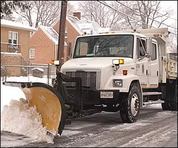Suggested fixes to Prince George’s snow removal policies
The Prince George’s County Council will soon convene a public meeting with officials from the Department of Public Works & Transportation (DPW&T) to discuss the county’s response to and management of the recent back-to-back snowstorms in February 2010.
The goal of this event, according to council chairman Thomas E. Dernoga (D-Dist. 1) and council member Samuel H. Dean (D-Dist. 6), is to review what happened and to determine what improvements are necessary to better handle future snow events.
On numerous occasions, I have personally experienced the negative ramifications of the county’s currently inadequate and inefficient snow removal process, both as a pedestrian and a driver. Here are some suggestions for county officials to improve the snow removal process, particularly pedestrian and transit rider safety:
12 hours in denser areas: The County should immediately amend its sidewalk ordinance to state that all property owners and lawful occupants of vacant or improved lots in the Developed Tier and in Centers and Corridors are responsible for removing ice and snow from abutting sidewalks and away from abutting fire hydrants and drains within 12 hours after the precipitation ends (or by the immediately following noon, if the 12-hour period expires between 5:00 pm and 5:00 am).
- Sidewalks should be cleared to a minimum width of four feet and, if ice cannot be removed, the pathway should be treated with salt, sand, or other de-icing material.
- County inspectors (who could be specially trained, unpaid deputy volunteers, such as civic league members) should begin inspection/enforcement patrols no later than 18 hours after the precipitation ends.
- Properties in violation of the sidewalk ordinance should be photographed, cited, and fined (no warnings) and ordered to comply no later than 36 hours after precipitation ends.
- Properties not cleared by that point should be cleared by the county within 48-60 hours after precipitation, and the property should be assessed the costs of cleanup.
- Elderly and disabled property owners and occupants should be able to have snow removed at the county’s expense or for a reduced fee. Absent or vacationing property owners should likewise be able to register with the county for a reasonable fee to have snow removed from their sidewalks.
- Street plowing in Centers and Corridors, and along commuter and school routes, should be done in a manner that will not obstruct sidewalks, bus stops, etc., even if that means that not all roadway lanes will be available. For example, a 2-lane road should be reduced to 1.5 lanes if plowing the full 2 lanes would block an adjoining sidewalk.
36 hours in other areas: All other county property owners (in the Rural and Developing tiers and outside of Centers and Corridors) should be required have snow and ice removed from sidewalks, fire hydrants, and drains within 36 hours after the snowfall.
- Systematic enforcement by the county of the snow ordinance in these areas would be optional, but inspectors would follow up on reports/complaints from neighbors and cite property owners appropriately.
- Properties found to be in violation should be ordered to comply within 18 hours following citation, and county cleanup would be provided within 36 hours following citation.
General policies:
- The County should be fully prepared at all times to handle snowfalls with accumulations of up to 12 inches. If greater accumulation is anticipated, the county’s contingency plans should be designed to marshal the necessary outside resources and private contractors so that its regular snow removal time frames are not extended by more than 24-36 hours.
- All residential roadways in Centers and Corridors and in the Developed Tier should be made truly “passable” (i.e., no more than 3 inches of packed snow and properly salted/sanded) within 24-36 hours after a normal snowfall and should be plowed to bare pavement within 72 hours.
- The county should implement snowplow-tracking technology, such as that used in Howard County, so that DPW&T and the residents have up-to-date, real-time information on snow removal progress.
- County officials should post written updates on snow removal progress no fewer than once every eight hours for the duration of a snow emergency. It is inexcusable that even though the snow emergency that was declared on February 5 had still not been lifted as of February 18, the last official snow removal update we received from county officials was at 11:00 a.m. on February 10, in the midst of the second round of the blizzard.
- Within 6 hours after a declaration of a snow emergency, and before the snow starts to cripple the community, cars parked on snow emergency routes and on the odd-numbered side of non-snow emergency routes should be ticketed and, if they would interfere with snow removal efforts, they should be towed.
Do you have additional or different suggestions?

